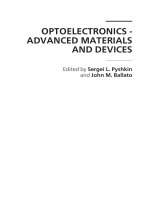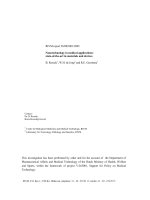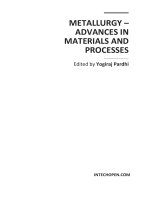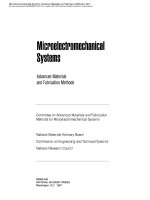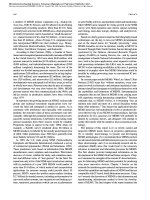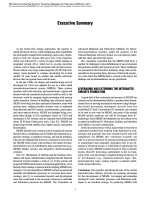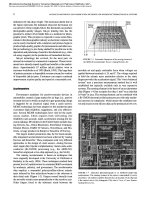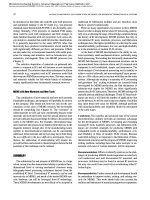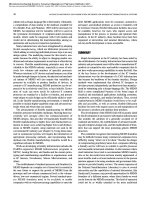OPTOELECTRONICS ADVANCED MATERIALS AND DEVICES docx
Bạn đang xem bản rút gọn của tài liệu. Xem và tải ngay bản đầy đủ của tài liệu tại đây (41.08 MB, 494 trang )
OPTOELECTRONICS ADVANCED MATERIALS
AND DEVICES
Edited by Sergei L. Pyshkin
and John M. Ballato
Optoelectronics - Advanced Materials and Devices
/>Edited by Sergei L. Pyshkin and John M. Ballato
Contributors
Bruno Ullrich, Z. Xie, J.C. Fan, Meichun Huang, Guijiang Lin, Jingfeng Bi, Minghui Song, Jianqing Liu, Weiping Xiong,
Gabriel Bernardo, David Bucknall, Abdelhakim Nafidi, Ayse Turak, Venkatachalam Shanmugam, Jin-Gang Liu, YuanZheng Guo, Hai-Xia Yang, Shiyong Yang, Vladimir G. Krasilenko, Aleksandr Nikolskyy, Alexander Lazarev, Sergei L.
Pyshkin, John Ballato, Hiroki Kishikawa, Nobuo Goto, Moises Rivas Lopez, Wendy Flores F., Marc Savanier, Filippo
Ghiglieno, Xavier Lafosse, Aristide Lemtre, Ivan Favero, Sara Ducci, Giuseppe Leo, Cécile Ozanam, Loïc Lanco, Ulrich
H.P. Fischer-Hirchert, Nibir Dhar, Ashok K Sood, Nuri Emanetoglu, Wang Zhang, Giulia Innocenti Bruni, Florin
Stanculescu, Patrice Salzenstein
Published by InTech
Janeza Trdine 9, 51000 Rijeka, Croatia
Copyright © 2013 InTech
All chapters are Open Access distributed under the Creative Commons Attribution 3.0 license, which allows users to
download, copy and build upon published articles even for commercial purposes, as long as the author and publisher
are properly credited, which ensures maximum dissemination and a wider impact of our publications. After this work
has been published by InTech, authors have the right to republish it, in whole or part, in any publication of which they
are the author, and to make other personal use of the work. Any republication, referencing or personal use of the
work must explicitly identify the original source.
Notice
Statements and opinions expressed in the chapters are these of the individual contributors and not necessarily those
of the editors or publisher. No responsibility is accepted for the accuracy of information contained in the published
chapters. The publisher assumes no responsibility for any damage or injury to persons or property arising out of the
use of any materials, instructions, methods or ideas contained in the book.
Publishing Process Manager Iva Lipovic
Technical Editor InTech DTP team
Cover InTech Design team
First published January, 2013
Printed in Croatia
A free online edition of this book is available at www.intechopen.com
Additional hard copies can be obtained from
Optoelectronics - Advanced Materials and Devices, Edited by Sergei L. Pyshkin and John M. Ballato
p. cm.
ISBN 978-953-51-0922-8
free online editions of InTech
Books and Journals can be found at
www.intechopen.com
Contents
Preface IX
Chapter 1
Advanced Light Emissive Device Structures 1
Sergei L. Pyshkin and John Ballato
Chapter 2
ZnO-Based Light-Emitting Diodes 25
J.C. Fan, S.L. Chang and Z. Xie
Chapter 3
Technological Challenges for Efficient AlGaAs Nonlinear
Sources on Chip 59
M. Savanier, C. Ozanam, F. Ghiglieno, L. Lanco, X. Lafosse, A.
Lemtre, I. Favero, S. Ducci and G. Leo
Chapter 4
InP/InGaAS Symmetric Gain Optoelectronic Mixers 91
Wang Zhang and Nuri W. Emanetoglu
Chapter 5
Preparation and Characterization of Nanostructured TiO2 Thin
Films by Hydrothermal and Anodization Methods 115
S. Venkatachalam, H. Hayashi, T. Ebina and H. Nanjo
Chapter 6
Correlation Between Band Structure and Magneto- Transport
Properties in n-type HgTe/CdTe Two-Dimensional
Nanostructure Superlattice. Application to Far-Infrared
Detection 137
Abdelhakim Nafidi
Chapter 7
Advances in Infrared Detector Array Technology 149
Nibir K. Dhar, Ravi Dat and Ashok K. Sood
Chapter 8
Theoretical Analysis of the Spectral Photocurrent Distribution
of Semiconductors 191
Bruno Ullrich and Haowen Xi
VI
Contents
Chapter 9
Recent Progress in the Understanding and Manipulation of
Morphology in Polymer: Fullerene Photovoltaic Cells 207
Gabriel Bernardo and David G. Bucknall
Chapter 10
Dewetting Stability of ITO Surfaces in Organic
Optoelectronic Devices 229
Ayse Turak
Chapter 11
Organo-Soluble Semi-Alicyclic Polyimides Derived from
Substituted-Tetralin Dianhydrides and Aromatic Diamines:
Synthesis, Characterization and Potential Applications as
Alignment Layer for TFT-LCDs 269
Jin-gang Liu, Yuan-zheng Guo, Hai-xia Yang and Shi-yong Yang
Chapter 12
Aromatic Derivatives Based Materials for Optoelectronic
Applications 291
Florin Stanculescu and Anca Stanculescu
Chapter 13
Optoelectronic Oscillators Phase Noise and Stability
Measurements 337
Patrice Salzenstein
Chapter 14
Design and Modeling of Optoelectronic Photocurrent
Reconfigurable (OPR) Multifunctional Logic Devices (MFLD) as
the Universal Circuitry Basis for Advanced Parallel HighPerformance Processing 349
Vladimir G. Krasilenko, Aleksandr I. Nikolskyy and Alexander A.
Lazarev
Chapter 15
All-Optical Autonomous First-in–First-out Buffer Managed with
Carrier Sensing of Output Packets 375
Hiroki Kishikawa, Hirotaka Umegae, Yoshitomo Shiramizu, Jiro Oda,
Nobuo Goto and Shin-ichiro Yanagiya
Chapter 16
A Method and Electronic Device to Detect the Optoelectronic
Scanning Signal Energy Centre 389
Moisés Rivas, Wendy Flores, Javier Rivera, Oleg Sergiyenko, Daniel
Hernández-Balbuena and Alejandro Sánchez-Bueno
Chapter 17
Opto-Electronic Packaging 419
Ulrich H. P. Fischer
Contents
Chapter 18
III-V Multi-Junction Solar Cells 443
Gui jiang Lin, Jingfeng Bi, Minghui Song, Jianqing Liu, Weiping
Xiong and Meichun Huang
Chapter 19
Use of Optoelectronic Plethysmography in Pulmonary
Rehabilitation and Thoracic Surgery 471
Giulia Innocenti Bruni, Francesco Gigliotti and Giorgio Scano
VII
Preface
Optoelectronics, as the discipline devoted to the study and application of electronic
devices that emit, detect, and otherwise control light, has widely proliferated around
the world and enabled many of today’s modern conveniences. Despite this ubiquity,
new applications and novel optical phenomena continue to drive innovation.
Accordingly, there is a need to compile advances and new achievements for specialists
and all who are interested. Thus InTech – Open Access Publisher has developed this
offering, Optoelectronics – Book II, as the second part of the InTech collection of
international works on optoelectronics.
As with the first book Optoelectronics - Materials and Techniques, edited by Professor
P. Predeep, this book covers recent achievements by specialists around the world. With
pleasure we note the growing number of countries participating in this endeavor
including Brazil, Canada, China, Egypt, France, Germany, India, Italy, Japan, Malaysia,
Mexico, Moldova, Morocco, Netherlands, Portugal, Romania, Saudi Arabia, South
Korea, Taiwan, Ukraine, USA, and Vietnam.
Our joint participation in this book and writing of one of its Chapters also testifies to
the unifying effect of science. We started this book from the Chapter entitled
“Advanced Light Emissive Device Structures” which highlights the progression in
properties of a unique collection of aged GaP crystals grown over 50 years ago and now
exhibit very interesting optoelectronics features and offer fundamental insights into
solid state physics over such time scales.
We purposely do not divide the book into separate sections, as I common, because
many of the Chapters are devoted to differing aspects of optoelectronics, including
materials and their characterization, through device structures and applications.
However, we tried to gather chapters of similar theme are together. An interested
reader will find in the book the description of properties and applications employing
organic and inorganic materials, such as different polymers, oxides and
semiconductors, as well as the methods of fabrication and analysis of operation and
regions of application of modern optoelectronic devices.
X
Preface
We are grateful to the authors and hope that the contribution of authors and number of
participating countries with continue to grow, while optoelectronics itself will be the
object in permanent demand to further enhance human quality of life.
Editor:
Sergei L. Pyshkin
Professor, Principal Investigator
Institute of Applied Physics
Academy of Sciences of Moldova
Kishinev, Moldova
Adjunct-Professor, Senior Fellow
Clemson University
South Carolina, USA
Co-editor:
John M. Ballato
Professor, Director
Center for Optical Materials Science and Engineering Technologies
School of Engineering and Materials Science
Clemson University
South Carolina, USA
Chapter 1
Advanced Light Emissive Device Structures
Sergei L. Pyshkin and John Ballato
Additional information is available at the end of the chapter
/>
1. Introduction
This Chapter contains our latest achievements on organic and inorganic light emitters for
display and waveguide applications. Two simultaneous efforts are described and analyzed.
The first is the application of some transparent polymers to photoactive device structures.
The second area focuses on the fabrication of optoelectronically-important structures based
on GaP nanoparticles and their composites. The choice of materials are further complemen‐
tary since they each are considered candidates for use in all optical circuits with commercial
interest for light emitters, waveguides, converters, accumulators and other planar, fiber or
discrete micro-optic elements.
Three objectives have been fulfilled and are reported here: 1) the development of new tech‐
nologies for the preparation of nanocrystalline composite and GaP films; 2) the fabrication of
novel optical planar light emissive structures for light emissive devices based on GaP/poly‐
mers nanocomposites; and 3) the generalization of experimental results from light emissive
GaP bulk crystals, nanoparticles and nanocomposites.
Photoluminescence (PL), Raman light scattering (RLS), X-ray diffraction (XRD), atomic force
and transmission electron microcopies (AFM and TEM) and other diagnostic methods have
been used to characterize quality of GaP bulk and nanocrystals, GaP/polymers nanocompo‐
sites and to evaluate emissive efficiency of the obtained device structures. New solutions
based on growth technique with use of modern analytical techniques were applied for
growth and monitoring of semiconducting and composite films and fibers.
One of the main results described in the present Chapter is the creation and investigation
of nanocomposite films based on GaP nanoparticles inserted into optically transparent
polymers to prepare unique light emissive devices for optoelectronic applications. Differ‐
ent polymers were tested that combine the processability and durability of engineering
© 2013 Pyshkin and Ballato; licensee InTech. This is an open access article distributed under the terms of the
Creative Commons Attribution License ( which permits
unrestricted use, distribution, and reproduction in any medium, provided the original work is properly cited.
2
Optoelectronics - Advanced Materials and Devices
thermoplastics with suitable for GaP nanoparticles optical, electrical, thermal, and envi‐
ronment resistant properties.
Perfect single crystals from our unique collection of pure and doped GaP single crystals [1-25]
compared with GaP nanoparticles prepared by us [26-31] serve as a standard yielding funda‐
mental new knowledge and insights into semiconductor optical physics. Elaborating optimal
methods of fabrication of GaP nanoparticles and their light emissive composites with compati‐
ble polymers [32-36] we use our own experience and literature data [37-39]. Due to considera‐
ble efforts in the past, including our contribution also, GaP has received significant attention as
a material for use in a wide range of important modern optoelectronic devices including pho‐
todetectors, light emitters, electroluminescent displays and power diodes as well as being a
model material with which to investigate the fundamental properties of semiconductors.
These two components of the composites, GaP and specially selected polymers, were unified
based on their compatibility with the light emission spectral region as well as in their eventual
integration into all optical circuits where bulk crystals or nanocrystals of GaP have been of
commercial interest mainly for fiber and planar light emissive and micro-optic elements.
We hope our device structures obtained with application of accumulated for years results in
their optics and technology [1-36, 41-43] will have significant commercial value because they
present a new optical medium and product.
2. Development of technology for growth of GaP nanocrystals
While bulk and thin film GaP has been successfully commercialized for many years, its ap‐
plication in nanocomposites as a new optical medium has only received attention recently.
This section reviews our recent efforts to advance the quality of GaP nanoparticles for light
emissive devices based on polymer/GaP nanocomposites.
This activity is the important milestone in the creation of the nanocomposites for advanced
light emissive device structures because GaP nanoparticles having the necessary lumines‐
cent and electroluminescent properties and compatible with a polymer matrix is a key ele‐
ment of these structures. We hope the described here some details and parameters of the
technological processes used for fabrication of GaP nanocrystals with the improved and nec‐
essary for concrete application characteristics of luminescence will be useful in further elab‐
oration of the relevant optoelectronic devices.
The quality of GaP nanoparticles was improved using mild aqueous synthesis and different
colloidal reactions of Ga and P sources in toluene [26-38]. We used these methods taking in‐
to account that success of our activity depends on optimal choice of the types of chemical
reactions, necessary chemicals and their purity, conditions of the synthesis (control accura‐
cy, temperature, pressure, duration, etc.), methods and quality of purification of the nano‐
crystals, storage conditions for nanoparticles used in the further operations of fabrication of
the GaP/nanocomposites.
Advanced Light Emissive Device Structures
/>
Ultrasonication and ultracentrifugation have been applied during the synthesis and selec‐
tion of nanoparticles to increase their quality and to select them on dimensions.
The relevant spectra of photoluminescence and Raman light scattering, X-ray diffraction and
electron microscopy of the nanoparticles prepared under different conditions have been
compared with each other as well as with those from bulk single crystals. Thoroughly-pre‐
pared powders and suspensions of the nanoparticles have been used for preparation of GaP
film nanocomposites on the base of different polymers compatible with the nanoparticles on
optical and mechanical properties.
2.1. Equipment for fabrication of nanoparticles, fluoropolymers and nanocomposites
The equipment for fabrication of fluoropolymers and polymer nanocomposites has been ela‐
borated by the author (JB) from Clemson University during our joint activity on light emis‐
sive structures. This equipment and approaches were applied to our specific needs without
any serious modification.
2.1.1. Equipment for sublimation of phosphorus
It was found the synthesis on the base of white phosphorus gives the best quality of GaP nano‐
particles. Due to the known prohibition for free sale of white phosphorus we have elaborated
the facilities for its preparation using sublimation of its red modification (see Figure 1).
Figure 1. Preparation of white phosphorus.
The device is the silica tube, which is hermetic to the air, and is heated from one end while
the P vapor is transferred by a neutral gas (nitrogen or argon) environment at the other
cooled end of the tube where it is condensed there to form white phosphorus. After comple‐
tion of the process the white phosphorus can be removed; the tube must be immersed into a
water bath that to avoid inflammation of phosphorus in air.
The obtained white phosphorus must be stored as a water suspension. Then this suspen‐
sion by melting in boiled water is turned into the substance using in the synthesis of
GaP nanoparticles.
2.1.2. Equipment for hydrothermal and colloidal synthesis
A new model of autoclave for the hydrothermal synthesis of GaP nanoparticles from the ap‐
propriate chemical solutions has been established given the requisite high temperatures (up
3
4
Optoelectronics - Advanced Materials and Devices
to 500°C) for the organic solvents using GaCl3•6H2O and white phosphorus as precursors.
Software for the process of synthesis at the temperature control and regulation with the ac‐
curacy of 0.1°C has been developed.
The key part of the method are the chemical reactions at high temperature and pressure. The
reactor here is a hollow hermetic teflon cylinder. The necessary temperature (125°С, 200°С)
inside the cylinder is obtained by its heating, while the pressure – by evaporation of water.
Figure 2. Equipment for preparation of GaP nanocrystals on the base of NaBH4 or Na3P.
The equipment for colloidal synthesis of GaP nanocrystals using NaBH4 or Na3P in toluene
is shown in Figure 2.
2.2. Elaboration of technologies for fabrication of GaP nanoparticles
In 2005 the authors developed methods to fabricate GaP nanoparticles [26]. So, the technolo‐
gy and properties of the nanoparticles obtained in 2005-2006 and later [27, 28] are a good
reference point for comparison to the new data provided herein.
More recently the authors [31] have concentrated on low temperature methods to synthesize
GaP nanoparticles with improved luminescent characteristics. These methods are considera‐
bly different from those of other standard high temperature methods.
The first samples of GaP nanoparticles having a distinct luminescence at room temperature
were obtained by hydrothermal method from aqueous solutions at relative low temperature
(120-200°C). This method is discussed in Subsection 2.2.1. It was found that the composition
of the nanoparticles corresponds to stoichiometric GaP.
The colloidal method provides a good opportunity to control the conditions of the synthesis,
to decrease power inputs and to increase quality of nanoparticles concerning their purity
and uniformity of their dimensions. In actuality, the single parameter, which may be con‐
trolled in the other methods, is the temperature, while using colloidal methods one can con‐
trol nucleation of nanoparticles as well as velocity of their growth. The other important
advantage of the colloidal method is the ability of so called “capping”; that is to isolate
nanoparticles from each other, to prevent their agglomeration during storage, simultaneous‐
Advanced Light Emissive Device Structures
/>
ly inhibiting their further growth. Therefore, we have elaborated the methods of GaP nano‐
crystals colloidal synthesis using NaBH4 and Na3P compounds (Subsections 2.2.2 and 2.2.3).
2.2.1. Hydrothermal method of synthesis of GaP nanocrystals
Noted here are only essential details of the aqueous syntheses of GaP nanoparticles pre‐
pared at different temperatures and reaction conditions.
Using the literature data noted above the first nanocrystalline samples of GaP [26] have been
prepared. The first aqueous prepared, relatively monodisperse, well crystallized GaP nano‐
crystallites, exhibiting pronounced quantum confinement effect have been presented in [27].
The relevant reactions were carried out in an aqueous solution at 120-160°C. A typical syn‐
thesis was as follows: 35,0 ml H2O, 1,0 g Ga2O3, 1,0 g NaOH, 2,0 g white phosphorus were
added to a 50 ml Teflon –lined autoclave, and 1,5 g I2 then was added. The autoclave was
kept at 120-160°C for 8 hrs and then cooled to room temperature.
GaP nanoparticles were obtained in an alkali solution, taking advantage of the reaction of
Ga(OH)4 with PH3 which was produced from white phosphorus dispersed in alkali solution:
P4 + 3OH + 3H 2 O ® PH 3 + 3H 2 PO 2 Ga 2 O3 + 2OH - + 3H 2 O ® 2Ga ( OH )4
-
Ga(OH 4 - + PH 3 ® GaP + 3H 2 O + OH
(1)
-
The yield of GaP in alkali solution is only about 12%. In order to improve the yield of GaP
iodine was added to induce the reaction with white phosphorus, based on follow process:
P4 + 2I 2 + 4OH - + 4H 2 O ® 2PH 3 + 2H 3 PO 4 + 4I
(2)
The X-ray powder diffraction patterns of the as-prepared products indicated to the zinc
blend structure of GaP with a= 5.43 Å. Average crystallite size estimated by the Scherrer
equation are about 5 nm for GaP nanocrystals [27].
Nanoparticles of GaP have been prepared by mild aqueous synthesis at different tempera‐
tures, modifications and compositions of the reacting components.
NaOH pellets were dissolved in distilled water. Ga2O3, red or white phosphorus powder
and I2 were mixed and added to the NaOH solution. The mixed solution was then placed
into an autoclave and heated in an oven for 8 hours at 125 or 200°C. After the completion of
heating the autoclave was taken out of the oven and cooled. The obtained powder was fil‐
tered, washed with ethanol, HCl and distilled water and dried or ultrasonicated in the bath
with a special solvent for separation in dimensions and preparation of a suspension for any
nanocomposite. The dried powders were then characterized using standard methods of
XRD, TEM, Raman scattering and photoluminescence. For comparison industrial and spe‐
cially grown and aged GaP single crystals also were used [1, 24].
5
6
Optoelectronics - Advanced Materials and Devices
Figure 3. TEM images of GaP nanoparticles obtained by the aqueous synthesis. a. Thoroughly ultrasonicated and
dried nanopowder. b. Initial clusters with the dimensions of the order of 100 nm.
The instruments employed for Raman light scattering and luminescence measurements in‐
cluded spectrographs interfaced to a liquid nitrogen-cooled detector and an argon ion laser or
lamp excitation sources. Raman scattering spectra was obtained at room temperature by exci‐
tation with 514.5 nm radiation. Luminescence was excited by UV light of the lamps or the N2 la‐
ser nanosecond pulses at wavelength 337 nm and measured at room temperature [25-28].
Figure 3 shows the TEM images of GaP nanoparticles obtained by the aqueous synthesis.
The washed, thoroughly ultrasonicated and dried nanopowder contains mainly single 10nm
nanoparticles (Figure 3a), obtained from the initial clusters with the dimensions of the order
of 100 nm (Figure 3b).
Figure 4. Raman light scattering from GaP nanoparticles of different treatment (spectra 2-4) in comparison with per‐
fect GaP bulk crystals (spectrum 1).
Spectrum 2: Not thoroughly treated powder of nanoparticles prepared using red phospho‐
rus at 200°C. Spectrum 3: Thoroughly treated GaP nanoparticles prepared using red phos‐
phorus at 200°C. Spectrum 4: Nanoparticles prepared on the base of white P by low
temperature syntheses.
Advanced Light Emissive Device Structures
/>
Figure 4 shows the Raman light scattering spectra from GaP nanoparticles prepared us‐
ing white or red P in mild aqueous synthesis at increased or low temperatures and ul‐
trasonically treated.
In the colloidal method of the synthesis freshly prepared white phosphorus was used and
ultrasonicated in toluene. Here the mixture for the reaction of the synthesis consists of
GaCl3 . nH2O diluted in toluene and dry NaBH4. One of 2 fractions of different colors ob‐
tained in the synthesis was removed by rinsing in ethanol and water while the next one,
containing the nanoparticles, was treated in an high-speed ultracentrifuge.
The characteristic GaP Raman lines from aged GaP single crystals (Figure 4, spectrum 1) and
from the nanoparticles prepared using white P at low temperature (Figure 4, spectrum 4)
were narrow and intense whereas, nanoparticles prepared from red P at higher tempera‐
tures (Figure 4, spectra 2 and 3) were weak and broad; the especially weak and broad spec‐
trum exhibits not thoroughly washed powder (please see spectrum 2).
Figure 5. X-ray diffraction from GaP nanoparticles.1. White phosphorus, using low temperature syntheses, well-treat‐
ed powder. 2. White P, not the best performance and powder treatment. 3. Red phosphorus, the best result. 4. Perfect
GaP bulk crystal.
In Figure 5 one can see x-ray diffraction from the GaP nanoparticles prepared at different
conditions using red or white phosphorus (spectra 1-3) in comparison with the diffraction
from perfect GaP single crystal (spectrum 4). The nanoparticles obtained by low tempera‐
ture aqueous synthesis using white phosphorus exhibited clear and narrow characteristic
lines like those obtained from perfect GaP bulk single crystals taken from our unique collec‐
tion of long-term (app. 50 years) ordered GaP single crystals (Figure 5, spectra 1 and 4). Con‐
trary to that, nanoparticles prepared using red phosphorus or less-than-optimum conditions
showed broad and weak characteristic lines (Figure 5, spectra 2 and 3).
Any luminescence was absent in newly-made industrial and our freshly prepared crystals
but it was bright in the same app. 50 years aged crystals (Figure 6, spectrum 1; the features
of luminescence in the perfect aged crystals please see in [16-25]). Initial results on lumines‐
cent properties of GaP nanoparticles [26] confirmed the preparation of GaP nanoparticles
7
8
Optoelectronics - Advanced Materials and Devices
with dimensions of between 10-100 nm and clear quantum confinement effects but the lumi‐
nescent spectrum was not bright enough and its maximum was only slightly shifted to UV
side against the 2.24 eV forbidden gap at room temperature (Figure 6, spectrum 2). The
nanoparticles obtained from the reaction with white P at low (125°C) temperature exhibit
bright broad band spectra considerably shifted to UV side [27, 28, 36] (Figure 6, spectrum 3,
4). Note that the original powder contains only a part of GaP particles with nearly 10 nm
dimension, which develop quantum confinement effect and the relevant spectrum of lumi‐
nescence, so the spectrum of luminescence consists of this band with maximum at 3 eV and
of the band characterizing big particles with the maximum close to the edge of the forbidden
gap in GaP (Figure 6, spectrum 3), but thorough ultrasonic treatment gives an opportunity
to get the pure fraction of nanoparticles with the spectrum 4 having the maximum at 3 eV.
Figure 6. Luminescence of GaP nanoparticles prepared at different conditions (spectra 2-4) and in comparison with
the luminescence of perfect GaP bulk single crystals (1). Please see explanations in the text below.
With these results, one can compare the properties of GaP nanoparticles with those of bulk
single crystals grown in the 1960s or, approximately, 50 years ago [1-25]. The authors have
investigated their optical and mechanical properties [16-25] in the 1960s, 1970s, 1980s and
1990s. Due to a significant number of defects and a highly intensive non-radiative recombi‐
nation of non-equilibrium current carriers, initially luminescence from the freshly prepared
undoped crystals could be observed only at the temperatures 80K and below. Today, lumi‐
nescence is clearly detected in the region from 2.0 eV and until 3.0 eV at room temperature
(see Figure 6, spectrum 1). Taking into account that the indirect forbidden gap is only 2.25
eV, it is suggested that this considerable extension of the region of luminescence to the high
energy side of the spectrum as well as a pronounced increase of its brightness are connected
with a very small concentration of defects, considerable improvement of crystal lattice, high
transparency of perfect crystals, low probability of phonon emission at rather high tempera‐
ture and participation of direct band-to-band electron transitions.
Our unique collection of long-term-ordered perfect GaP single crystals provides opportuni‐
ties for deep fundamental analogies between perfect single crystals and nanoparticles
[29-31] as well as to predict and to realize in nanoparticles and perfect bulk crystals new and
interesting properties and applications as the advanced light emissive elements of relevant
Advanced Light Emissive Device Structures
/>
device structures. More detailed analyses and discussion of these results can be found in the
references cited above and will be futher published.
2.2.2. Synthesis of GaP nanocrystals on the base of NaBH4 compound
In the method employed here, NaBH4 was used as a deoxidizer during the synthesis in the
solvent – toluene, where the sources of Ga and P (white phosphorus) have been dissolved
(GaCl3) or suspended. NaBH4 can be used also due to its high solubility in ethanol. The etha‐
nol solution of NaBH4 was introduced into the process of the synthesis during 5 hours, con‐
trolling the velocity of its introduction at the moderate heating up to 70°С.
White-yellow precipitates were the result of the synthesis. The precipitate was rinsed multi‐
ple times in toluene, removing the remaining P and GaCl3, and then in water, removing the
water- soluble species such as NaCl. The centrifugal separation from the solvent has been
used for extraction of the final precipitate having a lemon color.
One can suppose the following scheme for the GaP synthesis:
2Ga 3 + 6BH 4 - ® 2Ga + 3B2 H 6 + 3H 2
4Ga + 4P ® 4GaP
4GaCl3 + 12NaBH 4 + 4P ® 4GaP + 12NaCl + 6B2 H 6 + 6H 2
(3)
The last reaction is the closing one, including creation of NaCl, which can be easily removed
with deionized water. The main problem of the described synthesis is the exclusion Ga met‐
al particles in the precipitate. The problem is controled via the rate of Ga ion deoxidation,
depending on temperature, the types of solvent and deoxidizer. Using low (~1 mL/min) rate
of introduction of NaBH4 ethanol solution into the process helps to avoid the metal Ga crea‐
tion.
2.2.3. Synthesis of GaP nanocrystals on the base of Na3P
For the preparation of Na3P we used elementary Na, white P and the mixture of InCl3/
GaCl3 (4 wt% InCl3 + 96 wt% GaCl3). The main experimental procedures can be described
as follows: a 5.2 g mixture of GaCl3 and InCl3 was dissolved in 150 ml of xylene. Then, 2 g
of sodium and 0.9 g of white phosphorus were added into the solution. The solution was
stirred at 100°C for 10 hrs. After the reaction, the product was filtered for 3 times in xy‐
lene and 3 times in deionized water. The resultant powders were dried in vacuum at 60–
80°C for 2 hrs. All the above mentioned manipulations were conducted in high purity ni‐
trogen (99.999%) atmosphere in a glove box. Lastly, three equal parts of the product was
heated respectively to 300°C, 480°C and 600°C for 1 hr in pure nitrogen (99.999%) flows.
The reactions can be expressed as:
9
10
Optoelectronics - Advanced Materials and Devices
6Na + InCl3 + GaCl3 = In + Ga + 6NaCl
In + P = InP
Ga + P = GaP
(4)
As the result the GaP nanoparticle aggregation was obtained. In a glove box, previously
purged with dry nitrogen, 1.2 g of white phosphorus (P4) and 1.7 g of sodium (Na) were
placed in 100 mL of distilled dimethylbenzene in an Erlenmeyer flask. The mixture was then
stirred, heated to 120°C and maintained at that temperature for 10 hrs. A black fragmented
product, Na3P, was obtained. About 10 g of gallium (Ga) pellets were added to a quartz tube
with one sealed end. The tube was purged with dry nitrogen and then heated gently. A
chlorine gas flow through the melting metal was put in place at a rate until all the gallium
reacted. The product - gallium chloride (GaCl3) was formed. In the glove box, 6.5 g of GaCl3
was dissolved in 100 mL of distilled dimethylbenzene in an Erlenmeyer flask. The solution
was stirred and heated to 100°C. Then 2.5 g of Na3P was added to the Erlenmeyer flask and
the mixture was heated at 100°C with continuous stirring for 2.5 hr. After cooling, the mix‐
ture was filtered and washed with water.
The alternative method for preparation of GaP nanocrystals is interaction of GaCl3 and Na3P:
GaCl3 + Na 3 P = GaP ( nanoparticles ) + 3NaCl
(5)
In this method the stoichiometric ratio of Na (99,9%) and P (99,995%) is placed in the reactor
with the Ar inert atmosphere. The reaction of preparation of Na3P goes between melted Na
and dispersed white P at 110°C in boiling toluene under intense stirring. This violent reac‐
tion must be supported at the necessary conditions (110°C and intense stirring) for 5 hrs. As
the result we have the black suspension of Na3P:
3Na + P ® Na 3 P
Figure 7. XRD spectrum of GaP nanocrystals prepared on the base of Na3P and GaCl3.
(6)
Advanced Light Emissive Device Structures
/>
According to elaborated by us technology [28, 31] the synthesis of GaP nanocrystals goes
in the toluene solvent between dissolved (GaCl3) and dispersed (Na3P) initial chemicals at
80°С under ultrasonic machining for 5 hrs, creating a black-brown precipitate, which
must be rinsed multiple times in toluene (removal of P and GaCl3) and water (removal of
the soluble matter like NaCl). A high speed centrifuge must be used for separation of the
precipitate. The resultant material must not be cleaned; its purity depends only on the pu‐
rity of the initial components.
The XRD spectrum of GaP nanocrystals prepared using Na3P and GaCl3 in toluene is pre‐
sented in Figure 7. One can observe the characteristic (111), (220) and (311) reflections for
GaP. However, there are some extraneous lines of the low intensity, probably, from NaCl,
NaPO3 and showing that purification of GaP nanoparticles was not enough. The extraneous
lines of the other than GaP components can be seen also in the spectra of GaP nanoparticles
obtained by the method of Energy Dispersion X-ray Analysis (EDAX).
In conclusion we note that the growth of GaP nanocrystals is the key element in the creation
of nanocomposite for advanced device structures because, in spite of the lack of the concrete
parameters and conditions of synthesis in the relevant literature sources, all the necessary
data for the preparation of GaP nanoparticles are provided herein.
Thus, nanoparticles of GaP have been prepared using white P by mild aqueous low temper‐
ature synthesis and 2 methods of colloidal chemistry. The spectra of PL, RLS, and XRD to‐
gether with TEM images of the nanoparticles prepared under different conditions have been
compared with each other as well as with those from bulk single crystals, from hydrother‐
mal and colloidal reactions in toluene were presented. Uniform GaP nanoparticles, follow‐
ing ultrasonic treatment yielded a bright luminescence at room temperature with a broad
band with maximum at 3 eV and have been used to prepare GaP/polymer nanocomposites.
3. Development of methods of incorporation of the GaP nanoparticles
into polymers
Polyglycidyl methacrylate (PGMA), polyglycidyl methacrylate-co-polyoligoethyleneglycol
methacrylate (PGMA-co-POEGMA) and biphenyl vinyl ether (BPVE) polymers were used
to synthesize GaP nanocomposites suitable for light emissive luminescent device struc‐
tures. Some other polymers, dielectrics and with high electric conductivity, will be also in‐
vestigated in the process of preparation of this Chapter and used for elaboration of light
emissive device structures.
Film nanocomposites of good quality with very bright and broad-band luminescence have
been prepared. Quality and surface morphology of the nanocomposite films was studied in
ambient air using AFM in taping mode on a Dimension 3100 (Digital Instruments, Inc.) micro‐
scope while luminescence of the nanocomposites films deposited by dip-coating from a sus‐
pension in water-ethanol mixture solution on the surface of a silica substrate was excited by the
N2 laser nanosecond pulses at wavelength 337 nm and measured at room temperature.
11
12
Optoelectronics - Advanced Materials and Devices
The nanocomposites on the base of the noted above polymers were used for preparation and
test of film light emissive device structures.
Thickness of the polymer composite film was within 250-300 nm defined from AFM scratch ex‐
periment. The following procedures have been used in the fabrication of the nanocomposites:
1.
GaP powder was ultrasonicated in methylethylketone (MEK) using Branson 5210 ultra‐
sonic bath. Then, PGMA was added to the MEK solution. GaP to polymer ratio was less
than 1:10.
2.
GaP powder was dispersed in water-ethanol mixture (1:1 volume ratio) and ultrasoni‐
cated using Branson 5210 bath for 120 min. Then, PGMA-co- POEGMA was added in
the form of water-ethanol mixture (1:1 volume ratio) solution. GaP to polymer ratio was
less than 1:3. Nanocomposite films were deposited on quartz slides via dip-coating;
3.
GaP powder was dispersed in the biphenyl vinyl ether/dichloromethane (BPVE/DCM)
solution; the solution was stirred and filtered from the excess of the powder. A few mL
drops of the settled solution were casted onto silicon wafer.
More details on preparation and characterization of our GaP/polymers nanocomposites can
be found in [31-36].
Figure 8. TEM image of GaP thoroughly ultrasonicated and dried nanoparticles obtained by mild aqueous synthesis
(a) and AFM topography image of the GaP/PGMA nanocomposite (b).
Figure 8a shows the TEM images of GaP nanoparticles obtained by the aqueous synthesis.
One can see GaP nanoparticles, having characteristic dimensions less than 10 nm. The wash‐
ed, thoroughly ultrasonicated and dried nanopowder contains mainly single nanoparticles,
while the same powder obtained without ultrasonic treatment consists of the clusters with
the dimensions of the order of 100 nm.
Figure 8b shows the AFM topography images of the GaP/PGMA film nanocomposite depos‐
ited by dip-coating from a suspension in water-ethanol mixture solution on the surface of a
silica substrate. The AFM images demonstrated that no significant aggregation was caused
by the polymerization. In general, individual particles were observed.
The thoroughly washed, ultrasonicated and dried nanopowders obtained by mild low tem‐
perature aqueous synthesis from white P as well as their specially prepared suspensions
Advanced Light Emissive Device Structures
/>
have been used for fabrication of blue light emissive GaP nanocomposites on the base of
some optically and mechanically compatible with GaP polymers. The relevant luminescence
spectra are presented in Figures 9 and 10.
Figure 9 shows the spectra for GaP/PGMA-co-POEGMA nanocomposites. Comparing the
results for the nanocomposites prepared from GaP powder or suspension (Figure 9, spectra
1 and 2 respectively), it was established that the best quality have the nanocomposites ob‐
tained from the nanoparticles stored as a suspension in a suitable liquid (see spectrum 2).
Figure 9. Spectra of luminescence from GaP/ PGMA-co-POEGMA nanocomposites. Nanoparticles have been pre‐
pared using white P by mild aqueous synthesis and stored as the dry powder (spectrum 1) or suspension in a liq‐
uid (spectrum 2).
Figure 10. Luminescence spectra of 2 GaP/BPVE nanocomposites produced on the base of 2 parties of GaP nanoparti‐
cles prepared using different conditions.
According to our measurements, the matrix polymers PGMA-co-POEGMA or BPVE used in
this work provide no contribution to the spectra of luminescence of the based on these ma‐
trixes GaP nanocomposites presented in Figures 9 and 10, so, the nanocomposite spectra co‐
13
14
Optoelectronics - Advanced Materials and Devices
incide with those obtained from the relevant GaP powders or suspensions. We note that in
the GaP/BPVE nanocomposite the position of the luminescent maximum can be changed be‐
tween 2.5 – 3.2 eV and the brightness is 20-30 more than in the PGMA and PGMA-co-POEG‐
MA matrixes. We explain the broadening of the luminescence band and the shift of its
maximum to low photon energies in luminescence of the nanocomposite based on the GaP
powder in Figure 9, spectrum 1, by the presence of the nanoparticles with the dimensions of
10-100 nm in the powder. Meanwhile, suspensions containing the 10 nm nanoparticles ex‐
hibit pronounced quantum confinement effects since this diameter equals the Bohr diameter
of the bound exciton in GaP.
Figures 9 and 10 present a clear image of the quantum confinement effect in the GaP nano‐
particles. In accord with our data [28-30] the shift is about a few tenths of eV and, obviously,
it is impossible to explain only through this effect the dramatic 1 eV enhancement to the re‐
gion of luminescence at 300 K on the high-energy side of the spectrum.
In order to explain this interesting phenomenon we postulate that the nanocrystals, much like
the ideal long-term ordered bulk GaP single crystals, exhibit this huge increase in blue-shifted
luminescence due to: (a) negligibly small influence of defects and non-radiative recombination
of electron-hole pairs and very high efficiency of their radiative annihilation, (b) high perfec‐
tion of nanocrystal lattice, and (c) high transparency of nanocrystals due to their small dimen‐
sions for the light emitted from high points of the GaP Brillouin zones, for instance, in the direct
transitions Γ1c - Γ15v between the conductive and valence bands with the photon energy at
300°K equal to 2.8 eV [40] and (d) high efficiency of this so called “hot” luminescence.
Our first attempts to prepare GaP nanoparticles [26] yielded room temperature lumines‐
cence with maximum shifted only to 2.4 eV in comparison with the new maximum at 3.2 eV.
It confirms significant achievements in technology of GaP nanoparticles and GaP/polymers
nanocomposites. On the base of these improved technologies for preparation of GaP nano‐
particles and GaP/polymer nanocomposites we can change within the broad limits the main
parameters of luminescence and expect to create a framework for novel light emissive de‐
vice structures using dramatic 1 eV expansion of GaP luminescence to UV region.
The film device structures demonstrate broadband luminescence in the region from UV un‐
til yellow-red with controlled width and position of maximum with the luminous intensity
up to 1 cd compared with industrial light emitting diodes.
4. Comparison of properties of the GaP nanocrystals and perfect bulk
single crystals
Jointly with Refs. [1-31] this section is a generalization of the results on long-term observa‐
tion of luminescence, absorption, Raman light scattering, and microhardness in bulk semi‐
conductors in comparison with some properties of the best to the moment GaP nanocrystals.
We show that the combination of these characterization techniques elucidates the evolution
of these crystals over the course of many years, the ordered state brought about by pro‐
Advanced Light Emissive Device Structures
/>
longed room-temperature thermal annealing, and the interesting optical properties that ac‐
company such ordering. We demonstrate that long-term natural stimuli improve the
perfection of our crystals, which can lead to novel heterogeneous systems and new semicon‐
ductor devices with high temporal stability.
Our unique collection of long-term ordered perfect GaP single crystals gives opportunities
to find deep fundamental analogies in properties of the perfect single crystals and nanopar‐
ticles as well as to predict and to realize in nanoparticles and perfect bulk crystals new inter‐
esting properties and applications.
The long-term ordering of doped GaP and other semiconductors has been observed as an
interesting accompanying process, which can only be studied in the situation when one has
a unique set of samples and the persistence to observe them over decade time scales.
Any attempt to accelerate the above noted processes, for instance, through annealing of GaP
at increased temperatures cannot be successful because high-temperature processing results
in thermal decomposition (due to P desorption) instead of improved crystal quality. There‐
fore successful thermal processing of GaP can only take place at temperatures below its sub‐
limation temperature, requiring a longer annealing time. Evaluated within the framework of
the Ising model the characteristic time of the substitution reaction during N diffusion along
P sites in GaP:N crystals at room temperature constitutes 10 -15 years [5]. Hence, the obser‐
vations of luminescence of the crystals made in the sixties and the nineties were then com‐
pared with the results obtained in 2009-2012 in closed experimental conditions.
The pure and doped GaP crystals discussed herein were prepared nearly 50 years ago.
Throughout the decades they have been used to investigate electro- and photoluminescence
(PL), photoconductivity, bound excitons, nonlinear optics, and other phenomena. Accord‐
ingly, it is of interest also to monitor the change in crystal quality over the course of several
decades while the crystal is held under ambient conditions.
More specifically, since 2005, we have analyzed the optical and mechanical properties of sin‐
gle crystalline Si, some III–V semiconductors, and their ternary analog CdIn2S4, all of which
were grown in the 1960s. Comparison of the properties of the same crystals has been per‐
formed in the 1960s, 1970s, 1980s, 1990s [1-12], and during 2000s [13–25] along with those of
newly made GaP nanocrystals [26-28] and freshly prepared bulk single crystals [19-23]. We
improved in the preparation of GaP nanocrystals the known methods of hydrothermal and
colloidal synthesis taking into account that success of our activity depends on optimal
choice of the types of chemical reactions, necessary chemicals and their purity, conditions of
the synthesis (control accuracy, temperature, pressure, duration, etc.), methods and quality
of purification of the nanocrystals, storage conditions for nanoparticles used in the further
operations of fabrication of the GaP/nanocomposites.
Single crystals of semiconductors grown under laboratory conditions naturally contain a
varied assortment of defects such as displaced host and impurity atoms, vacancies, disloca‐
tions, and impurity clusters. These defects result from the relatively rapid growth conditions
and inevitably lead to the deterioration of the mechanical, electric, and optical properties of
the material, and therefore to rapid degradation of the associated devices.
15
